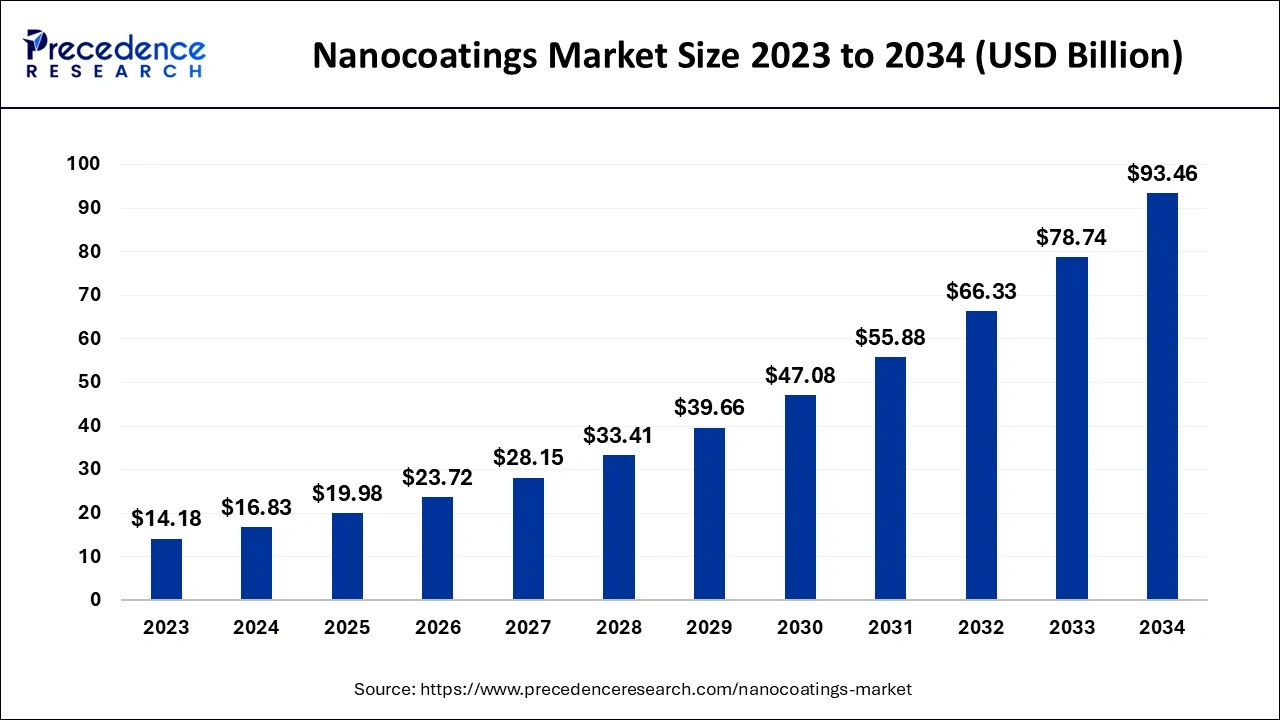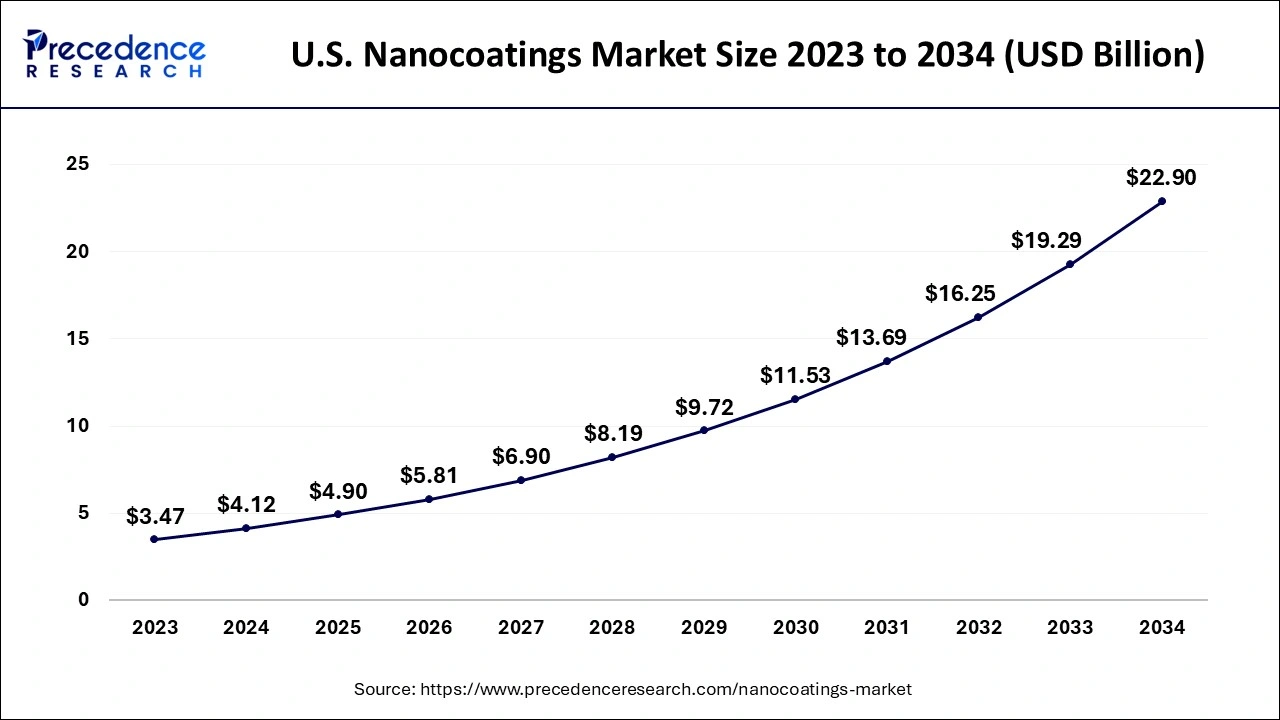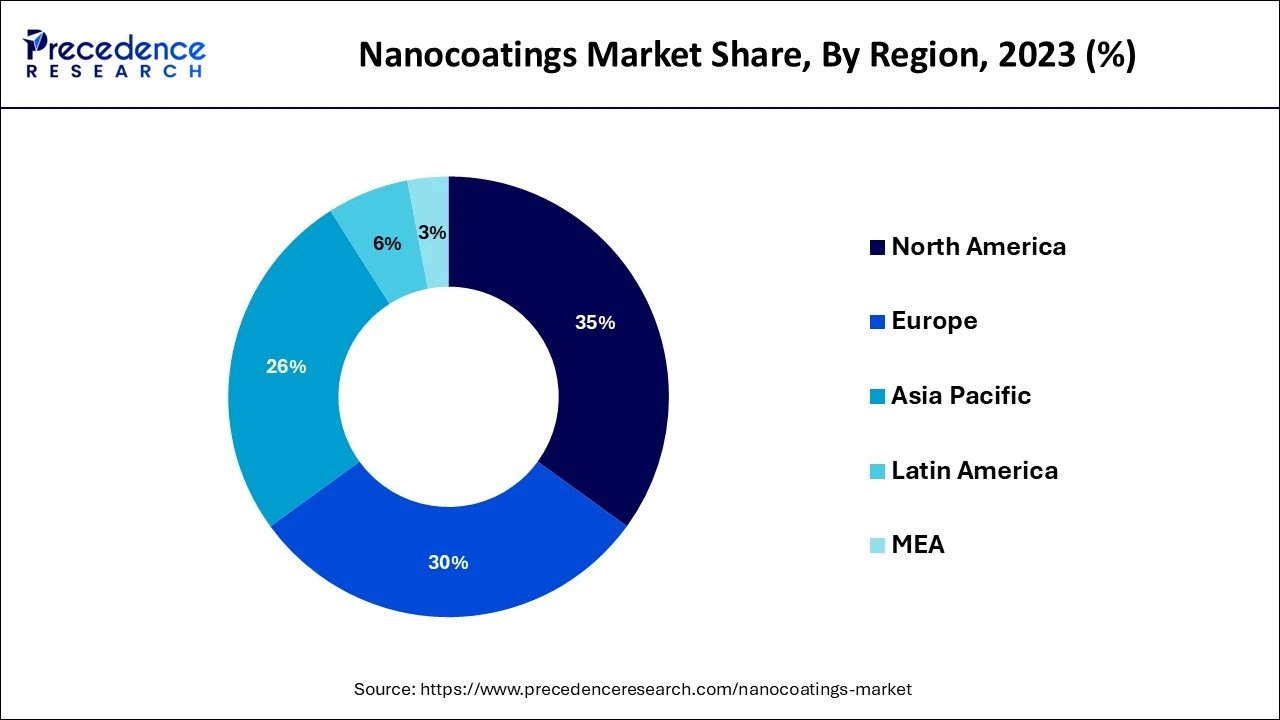The global nanocoatings market size accounted for USD 16.83 billion in 2024, grew to USD 19.98 billion in 2025 and is predicted to surpass around USD 93.46 billion by 2034, representing a healthy CAGR of 18.70% between 2024 and 2034. The North America nanocoatings market size is calculated at USD 5.89 billion in 2024 and is expected to grow at a fastest CAGR of 18.71% during the forecast year.
The global nanocoatings market size is estimated at USD 16.83 billion in 2024 and is anticipated to reach around USD 93.46 billion by 2034, expanding at a CAGR of 18.70% from 2024 to 2034.

The U.S. nanocoatings market size is evaluated at USD 4.12 billion in 2024 and is predicted to be worth around USD 22.90 billion by 2034, rising at a CAGR of 18.71% from 2024 to 2034.

On the basis of geography, the region of North America has emerged as the largest market owing to the extensive demand and usage of nanocoatings in various sectors. Rapid acceptance to modern technology in this particular region has emerged as a major growth factor for the market. The huge number of construction activities that are carried out in this particular region has also emerged as a major opportunity for the growth of the market. As a result of the increasing spending capacity of the people, the demand for premium products has increased rapidly which emerges as another major opportunity for the growth of the nanocoatings market.

The utilization of premium vehicles has been observed in this particular region which increases the consumption of nanocoatings to a great extent. The expenditure that is made on construction and infrastructure has emerged as a major growth factor for the market in this region. The active participation of the government to encourage sustainable development has boosted the demand for nanocoatings to a great extent. The rapidly growing aerospace industry has also emerged as a major growth factor for the nanocoatings market.
The industry of electronics has also helped considerably by contributing a decent share as a result of the premium products that are demanded by the people. The research and development programs that are carried out in this region by the key market players emerge as a major growth factor for the market.
Nanocoatings are utilized for protecting a surface against dirt, corrosion, dust and damage which takes place as a result of the external environment. The external factors such as moisture, friction, bacteria, water and heat radiations have a direct impact on the surface which can be protected with the help of nanocoatings that provide a very thin layer which takes up all the external impressions falling on the surface. This thin layer of nano coating can be in the form of a chemical or material that is applied on the surface which needs protection.
The building and construction sector has emerged as a major consumer for nanocoatings as a result of the chances of damage and corrosion. The usage of nanocoating for the purpose of conserving the building materials has emerged as a major growing phase for the market. The products which are utilized in the construction sector become sustainable after they are coated with the help of nanocoatings. The property of abrasion resistant which is provided by the nanocoatings proves to be a very useful for increasing the life of the materials. Abrasion resistant products are highly demanded in the field of construction and building as it helps to provide a premium experience to the consumers and also helps to maintain the cost of the final products.
The automotive sector also makes use of such chemicals and materials that provide a premium look to the final products and also protect it against the external environmental impressions that have the capacity to change the appearance or quality of the final product. The outbreak of the pandemic had considerable impact on the market as a result of the reduced workforce. Various initiatives have been taken by the government in order to deal with the situation in the form of lockdowns and other restrictions. The demand and supply chain were hampered tremendously during the course of the pandemic.
The utilization of nanocoatings in the construction and building industry has emerged as a major opportunity for the market as it helps to provide protection against the external environmental impressions such as UV radiations and moisture which have a considerable impact on the quality of the final product. The durability of the structure mainly depends upon the quality of the materials that are utilized for construction. Protection against corrosion, abrasion and staining is provided with the help of nanocoatings.
Hydrophobic coatings are utilized in the construction and building industry to protect the materials against damp and rust which helps to improve the shelf life of the structure. The health care sector also makes use of nanocoatings on a large scale owing to the high risk of contamination which is involved. Properties such as self-cleaning are mainly applied in this particular sector to prevent the surface of the surgical from being infected and hence prevent hospital-acquired infections.
Hospital acquired infections has emerged as one of the major reasons for complicating a number of cases especially in the geriatric population who are vulnerable to external impressions. The utilization of nanotechnology in the automobile industry has also helped to boost the demand and supply of vehicles to a great extent. Properties such as anti-fingerprint and anti-corrosion are mainly used in this particular sector for the interiors and the electronics that are fixed inside the vehicles.
| Report Coverage | Details |
| Growth Rate from 2024 to 2034 | CAGR of 18.70% |
| Market Size in 2024 | USD 16.83 Billion |
| Market Size by 2034 | USD 93.46 Billion |
| Base Year | 2023 |
| Forecast Period | 2024 to 2034 |
| Segments Covered | Type, Coating Methods, Raw Material, Application, and Geography |
On the basis of type, the segment of self-cleaning has emerged as the largest segment under this category owing to the rapid demand of this facility among many consumers all over the world which helps to save a huge amount of time and effort. As a result of the busy lifestyle practices that are followed by the people it is not possible for everyone to constantly clean up a particular surface in order to maintain hygiene which is taken care with the help of this particular segment and hence makes it quite easier for the consumers in the long run. The segment of self-cleaning provides facilities such as Protection against foreign objects dust and other materials. The maintenance of the final product is reduced to a great extent with the help of this self-cleaning technology.
The segment of antimicrobial coatings it's mainly utilized in the healthcare sector where hygiene plays an important role for protecting vulnerable patients against hospital-acquired diseases and infections. The surgical instruments and equipment have a high exposure to microbial and bacterial infestations which can be protected with the help of this antimicrobial coating. The recent rules and regulations regarding hygiene and cleanliness in the healthcare sector has helped the market to record a considerable revenue over the period of time. The technology of self-cleaning is also applied by the glass industry for making the final product more attractive and durable. The property of scratch resistance helps to increase the life and look of the final product which increases the demand and supply.
On the basis of application, the segment of construction and building has emerged as the largest segment owing to the rapidly increasing number of new structures that are being erected all over the world as a result of urbanization. The durability of the construction materials is increase to a great extent with the use of nanocoatings. Advanced technological solutions are being employed for making the products of better quality that helps to increase the demand and supply. Properties such as thermal insulation, hydrophobic and hydrophilic coatings are used for increasing the shelf life of the raw materials as well as the final product.
The materials are protected against external climatic conditions and hence helps to maintain the quality of the product. Moisture proves to be a major factor that affects the quality of the construction materials and hence degrades the quality of the final product.
The entire infrastructure gets damaged with the effect of moisture which can be prevented with the help of nanocoatings. External climatic impressions are avoided with the help of the nanocoatings which are applied on the surface of the construction materials. Fungal and bacterial accumulation can we spotted on various surfaces which keeps the area damp. This can be avoided when the surface is coated by nanocoatings.
The life of the final product is increased considerably when it receives protection against external environmental impressions. The other segments which make use of nanocoatings includes the automobile industry, marine industry, electronics and the medical sector. Rapid demand for nanocoatings has been experienced by the automotive industry owing to the increasing demand for premium cars among the people.
By Type
By Coating Methods
By Raw Material
By Application
By Geography
For inquiries regarding discounts, bulk purchases, or customization requests, please contact us at sales@precedenceresearch.com
No cookie-cutter, only authentic analysis – take the 1st step to become a Precedence Research client